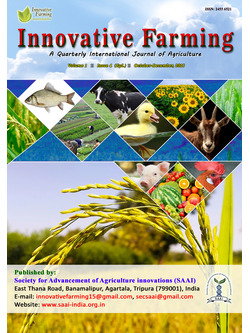
Exploitation of Heterosis in Cucurbits
Panchal Bhakti, B.*
ASPEE College of Horticulture and Forestry, Navsari Agriculture University, Navsari-396 450, Gujarat, India
N.B. Patel
ASPEE College of Horticulture and Forestry, Navsari Agriculture University, Navsari-396 450, Gujarat, India
A.I. Patel
ASPEE College of Horticulture and Forestry, Navsari Agriculture University, Navsari-396 450, Gujarat, India
S.N. Saravaiya
ASPEE College of Horticulture and Forestry, Navsari Agriculture University, Navsari-396 450, Gujarat, India
R.V. Tank
ASPEE College of Horticulture and Forestry, Navsari Agriculture University, Navsari-396 450, Gujarat, India
DOI: NIL
Keywords: Breeding, Cucurbits, Heterosis
Abstract
Heterosis refers as superiority or inferiority of hybrids over both the parents. Heterosis has been considered as one of the important breakthrough in the field of crop plant. Kolreuter studied artificial tobacco (Nicotiana spp.) hybrids for the first time in 1673. In 1876, heterosis was first described by Charles Darwin and he has concluded that hybrids from unrelated plant types were highly vigorous. In 1908, by Shull and East were individually advocated heterosis breeding as an alternative plant breeding strategy. Later on in 1914, Shull gave the term ‘heterosis’ as the developmental stimulus resulting from the union of different gametes and ‘hybrid vigour’ to manifest effects of heterosis. In vegetables, hybrid vigour was first observed by Hayes and Jones in cucumber for fruit size and fruit number in 1916. Further, Munger was the first to highlight to the possible utilization of F1 hybrids in muskmelon in 1942. In India, first report of hybrid was reported in chilli by IARI, New Delhi. Then continuous hybridization programme to be undertaken in India.
Downloads
not found
Reference
Airina, C.K., T. Pradeepkumar, T.E. George, P.G. Sadhankumar and S. Krishnan. 2013. Journal of Tropical Agriculture, 51(1-2): 144-148.
Kanzaria, S.G. 2012. Thesis, M. Sc. (Agri.), Navsari Agricultural University, Navsari.
Laxuman Patil, S.A. Salimath and P.R. Dharmatti. 2012. Karnataka J. Agric. Sci., 25(1): 14-17.
Mule, P.N., V. Khandelwal, V.A. Lodam, D.A. Shinde, P.P. Patil and A.B. Patil. 2012. Madras Agric. J., 99(7-9): 420-423.
Rai, N. and D.S. Yadav. 2005. Advances in Vegetable Production, Researchco Book Centre, New Delhi, p. 13.
Shaikh, J.A., K.B. Kathiria and R.R. Acharya. 2011. Veg. Sci., 38(2): 169-175.
Singh, A.K., R.S. Pan and P. Bhavana. 2013. The Bioscan, 8(4): 1533-1536.
Singh, R.A., K. Singh, Sanjay Kumar and B.K. Singh. 2012. Indian J. Hort., 69(2): 200-204.
Singh, S.K., R.K. Singh, S.S. Solankey and A.K. Upadhyay. 2012. Asian J. Hort., 7(2): 303-306.
